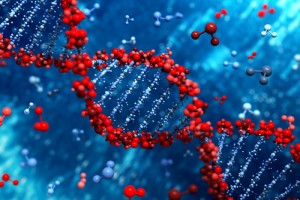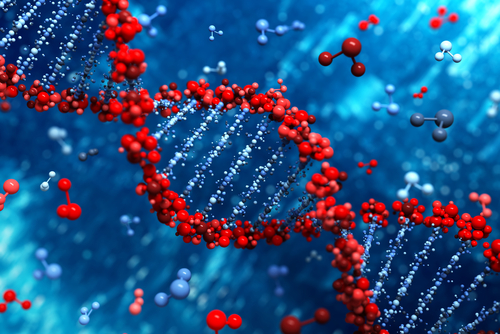 A new study by a team of scientists at the University of Iceland enhances understanding of how short DNA strands decompose in microseconds — knowledge relevant to cancer radiation therapy.
A new study by a team of scientists at the University of Iceland enhances understanding of how short DNA strands decompose in microseconds — knowledge relevant to cancer radiation therapy.
A Springer release reports that the researchers have discovered that DNA building blocks are susceptible to fragmentation on contact with the full range of ions from alkaline element species, finding new fragmentation pathways that occur universally when DNA strands are exposed to metal ions from a family of alkaline and alkaline earth elements. These ions tend to replace protons in the DNA backbone and at the same time induce a reactive conformation leading more readily to fragmentation.
These new research findings published in European Physical Journal D, entitled “Influence of metal ion complexation on the metastable fragmentation of DNA hexamers” (European Physical Journal D DOI: 10.1140/epjd/e2014-40838-7) are coauthored by Andreas Piekarczyk, Ilko Bald, Helga D. Flosadttir, Benedikt marsson, Anne Lafosse, and Oddur Inglfsson, all of the University of Iceland, and colleagues. They could contribute to optimizing cancerous tumor therapy through a greater understanding of how radiation and its by-products, reactive intermediate particles, interact with complex DNA structures.
In cancer radiation therapy, it is not the radiation itself that directly damages the DNA strands, or oligonucleotides. But rather, it is the secondary reactive particles, leading to creation of charged intermediates. The paper authors have studied one of these charged intermediates in the form of so-called protonated metastable DNA hexamers.
To do so, the authors created selected oligonucleotide-metal-ion complexes that they selected to have between zero and six metal ions. They then followed these complexes’ fragmentation reactions using a technique called time-of-flight mass spectrometry. By comparing the different species, they could deduce how the underlying metal-ion-induced oligonucleotide fragmentation works.
They discovered that metal ion-induced fragmentation of oligonucleotides is universal with all alkaline and alkaline earth metal ions, for example, lithium, Li+; potassium, K+; rubidium, Rb+; magnesium, Mg2+ and calcium, Ca2+. They had previously reached the same conclusion for sodium ions which are ubiquitous in nature, in the form of sodium chloride, or salt. Once the number of sodium ions per nucleotide is high enough, the study shows, it triggers an unexpected oligonucleotide fragmentation reaction.
The coauthors determine that quenching of the 3-CO backbone cleavage is not ion specific, since it is due to the removal of the phosphate protons upon replacement with the respective metal ions. The central nucleotide deletion competes with the 3-CO backbone cleavage channels and is thus promoted through the replacement of the exchangeable protons against metal ions. However, with increasing positive charge density of the metal ions the yield of the central nucleotide deletion further increases. The coauthors attribute this effect to the necessity of sufficient proximity of the terminal d(TT) group to allow for their recombination on this reaction path. Hence, the formation of a reactive conformer is mediated by the metal ions.
An article published July 15 by Physikalisch-Technische Bundesanstalt (PTB), Germany’s national metrology institute providing scientific and technical services, titled “How strongly does tissue decelerate the therapeutic heavy ion beam?” reports that PTB has developed a method for the more exact dosing of heavy ion irradiation in the case of cancer
The article notes that irradiation with heavy ions is suitable in particular for patients suffering from cancer with tumors which are difficult to access, for example in the brain, and that these particles hardly damage the penetrated tissue, but can be used in such a way that they deliver their maximum energy only directly at the target: the tumor.
The report observes that research in this relatively new therapy method is focussed again and again on the exact dosing: how must the radiation parameters be set in order to destroy the cancerous cells “on the spot” with as low a damage as possible to the surrounding tissue? The answer, say the authors, depends decisively on the extent to which the ions can be decelerated by body tissue on their way to the tumor.
[adrotate group=”1″]
They report that PTB scientists have established an experiment for the more exact determination of the stopping power of tissue for carbon ions in the therapeutically relevant area which is so far unique worldwide. Although the measurement data so far available must still become more exact, the following can already be said: The method works and can, in future, contribute to clearly improving the dosing for cancer therapy with carbon ions. The first results have recently been published in the magazine “Physics in Medicine and Biology” entitled “Stopping power of liquid water for carbon ions in the energy range between 1 MeV and 6 MeV” (Phys Med Biol. 2014 Jul 21;59(14):3683-95. doi: 10.1088/0031-9155/59/14/3683. Epub 2014 Jun 13 ) coauthored by J. M. Rahm, W. Y. Baek, H. Rabus and H. Hofsäss — all of Physikalisch-Technische Bundesanstalt, Department 6.6 at Braunschweig, Germany.
The coauthors note that stopping power of liquid water was measured for the first time for carbon ions in the energy range between 1 and 6 MeV using the inverted Doppler shift attenuation method, observing that the feasibility study carried out within the scope of the present work shows that this method is well suited for the quantification of the controversial condensed phased effect in the stopping power for heavy ions in the intermediate energy range.
They report that preliminary results of this work indicate that the stopping power of water for carbon ions with energies prevailing in the Bragg-peak region is significantly lower than that of water vapor. In view of the relatively high uncertainty of the present results, a new experiment with uncertainties less than the predicted difference between the stopping powers of both water phases is planned.
The PTB article notes that since human tissue mainly consists of water, it can therefore, be simulated well in liquid water in which form accelerated ions can be stopped on their way and at which target they deliver their maximum energy quantity — at least theoretically, because up to now experimental data has existed only for water vapor. Scientists however assume that if the aggregate state is neglected, the data determined for the determination of the radiation dose become too imprecise.
Within the scope of the doctoral thesis of paper coauthor J. M. Rahm, PTB scientists have now succeeded for the first time in determining the stopping power of liquid water for carbon ions with kinetic energies in the range of the maximum energy dissipation by experiment. The first results actually indicate that carbon ions are less strongly stopped in liquid water, related per molecule, than in water vapor.
As soon as more exact data are available, the findings will be included in the calibration of ionization chambers which are used to determine the dose in therapy planning. At present, the Heidelberg Ion-Beam Therapy Center (HIT) is the only institution in Europe which irradiates patients with heavy ions. The procedure applied by the researchers is based on a method which originates from nuclear physics: the Inverted Doppler Shift Attenuation Method. While the carbon ions excited by a nuclear reaction move through the water volume, they are stopped and fall back into their ground state. The energy distribution of the gamma quanta emitted thereby is recorded with the aid of an ultra-pure germanium detector. The Doppler effect, which leads to the displacement of the gamma energy, and the exponential-decay law allow the development of the velocity of the carbon ions with time to be pursued and, thus, conclusions on the stopping process to be drawn.
Sources:
Springer
European Physical Journal D
Physikalisch-Technische Bundesanstalt (PTB)
University of Iceland
Image Credit:
University of Iceland


